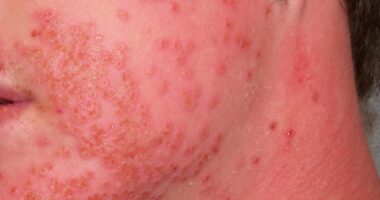In the last few years, the importance of gut health has taken center stage thanks to a growing body of science-backed evidence pointing to the impact a well-balanced microbiome can have on one’s longevity and overall well-being. But with so much information now available to us, decoding what an ideal digestive system really looks like—and how to improve gut health to support one—can be challenging. On the most recent episode of The Well + Good Podcast, two gut health experts revealed their golden rules (and top foods to eat) for a healthy gut. The takeaway: Although no approach is one-size-fits-all, achieving a healthier microbiome is something we can all accomplish.
Listen to the full episode here:
So, you want to heal your gut? Will Bulsiewicz, MD, a gastroenterologist and New York Times bestselling author of the books Fiber Fueled and the recently-released The Fiber Fueled Cookbook, and Brigitte Zeitlin, RD, a registered dietitian based in New York City, sat down with us to share their research-backed recs for how to improve gut health. Going back to the basics, the duo defined what the gut is comprised of (trillions, yes *trillions*, of microbes), how it plays a part in almost every biological system, and what to feed to keep it happy and healthy. (Turns out, those microbes are kind of picky eaters.)

What does gut health really mean, according to a gastroenterologist
In the episode, Dr. Bulsiewicz defines the gut as a community of 38 trillion (!) microorganisms. “If we were to lift our arms up really wide and grab all of the stars that exist within our galaxy and pull them in, I would have to place 380 galaxies full of stars into an individual person’s colon in order to meet the number of microbes that they have living inside of them right now,” Dr. Bulsiewicz says. Each of these microbes, he adds, has its own specialized function that enhances digestion and the ability to transform what we eat into fuel for our bodies.
Take fiber, for example. Dr. Bulsiewicz explains that we consume fiber through foods like plants, fruits, and vegetables. Still, their nutritional value alone isn’t as nearly powerful without the help of gut-friendly microbes. “With fiber, if we were sterile creatures [without any living bacteria in the gut], fiber would have zero nutritional value and really frankly, wouldn’t serve much of a purpose… maybe it would help our bowel movements, but that’s it,” Dr. Bulsiewicz says. “But when fiber comes into contact with the gut microbes living inside of our colon, they actually transform the fiber into what I would describe as the most anti-inflammatory compound: short-chain fatty acids.” When bacteria in your gut breaks down indigestible fibers and resistant starches through fermentation, short chain fatty acids are the byproduct of this natural process. These fatty acids are then absorbed by cells that line the gut where they are either metabolized or sent into circulation to provide energy to liver cells. Short chain fatty acids offer a bounty of health benefits, from reducing inflammation in your intestines to regulating immune function.
How your gut health plays a role in everyday life
“What we eat affects everything; every system,” Zeitlin says. When it comes down to what we eat, she clarifies that food not only fuels our body but can also have a major effect on other biological systems, including our mental and hormonal health. “The gut is frequently referred to as the second brain of our of our body because it affects everything the same way our brain affects everything,” she says.
Dr. Bulsiewicz agrees, and says that the more information he learned about nutritional science—and particularly, how food impacts the gut—during his medical training, the better physician be became. “I had my own health-related issues about 10 years ago…that moment that I thought I was being cursed [by my own digestive system] has turned into a blessing in disguise for me because it really empowered me and motivated me to be a better doctor and to study things that I was not taught in my medical training,” he says. According to Dr. Bulsiewicz, this naturally led him to ask the question, why are we not talking more about diet and lifestyle in medicine?, which helped spark inspiration for his Fiber Fueled books.
How to improve gut health
Like most things in life, eating for gut health is all about balance. “I certainly don’t eat a perfect diet,” Dr. Bulsiewicz says. “It’s just about making simple, sensible choices where you can level up your nutrition… So you can enjoy your food and simultaneously support your gut microbiome and reap the rewards of that.”
Although there isn’t one true “prescription” or meal plan for a perfectly healthy microbiome, Dr. Bulsiewicz says that most clinical research shows that a largely plant-based diet can have a positive impact on gut health. Plants contain tons of fiber, resistant starches, and polyphenols that feed a healthy gut. However, he notes that in a study by The American Gut Project with over 11,000 people across the globe, a powerful predictor of a healthy gut was the diversity of the plants you eat. “Every single plant has its own unique qualities and properties, [each] has its own strengths. And frankly, it has its own weaknesses, too. I realize this sounds weird, but [gut microbes] are kind of like us. They’re are picky eaters. They have their own dietary preferences. They don’t all like kale,” Dr. Bulsiewicz jokes. The study defines the magic number as 30 different plants per week to reap the most health benefits and cover all of the bases with any tough (microbe) customers.
In the episode, Dr. Bulsiewicz also points out that the backbone of a plant-predominant diet is not exclusively about fresh produce; rather, it’s hugely important to eat whole grains and legumes, too. “If you go around the world, for example, to the five Blue Zones, you will find [that]—even though they are in Japan, Greece, Sardinia, Costa Rica, and then in California—they’re all eating some variation of whole grains and legumes as the backbone of their diets,” he says.
Zeitlin refers to this diversity-of-plant-foods-first approach as “eating the rainbow,” and recommends aiming to eat three to four colorful foods a day. “I think [it’s a] really easy, tangible goal and tip to latch onto, and then you get to build and build from there,” she says. If that isn’t easily-digestible advice, I don’t know what is.
For additional details on supporting your gut health, listen to the full podcast episode here.
Ready to join the (podcast) conversation? At Well+Good, we spend our days talking to and learning from the most interesting people. Sign up to make sure you don’t miss out on an episode!
Experts Referenced
Our editors independently select these products. Making a purchase through our links may earn Well+Good a commission.









